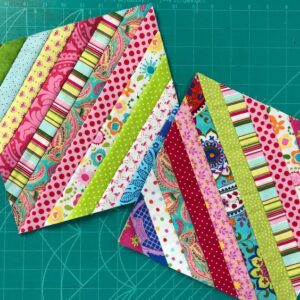Quilting, a traditional sewing art, continues to evolve with new techniques and designs.
One of the most popular methods is the “string quilt blocks,” which use strips of fabric to create vibrant and dynamic patterns. This article will explore the world of string quilt blocks, offering free patterns and creative ideas for quilting enthusiasts.
We will delve into four main areas: history and origin, how to create your own string quilt blocks, free patterns, and creative variations.

History and Origin of String Quilt Blocks
String quilt blocks have deep roots in the American quilting tradition, especially during times of economic hardship, such as the Great Depression. During this period, every piece of fabric was valued and reused, giving rise to a technique that utilized narrow strips of fabric, known as “strings.”
These strips were often leftovers from other sewing projects or old clothes, sewn together to create larger blocks that, when combined, formed unique and colorful quilts.
Besides economic necessity, string quilt blocks also served as a creative expression. Quilters could play with colors, textures, and patterns, resulting in vibrant and personal pieces. This technique not only saved resources but also offered an inclusive form of art, where even the smallest pieces of fabric could find a new purpose.
How to Create Your Own String Quilt Blocks
Creating string quilt blocks is an accessible and fun activity, suitable for both beginners and experienced quilters. Here is a step-by-step guide to get started:
Necessary Materials
- Fabric Strips (Strings): Use fabric scraps from other projects or cut new strips. The width can vary, usually between 1 to 2.5 inches.
- Fabric or Paper Base: Many quilters use a base to sew the strips onto, which can be lightweight fabric (like muslin) or newspaper.

- Sewing Machine: While it is possible to sew by hand, a sewing machine makes the process faster and more uniform.
- Iron: To flatten seams and ensure the blocks lie flat.

Step-by-Step Process
- Prepare the Base: Cut squares of fabric or paper to the desired size for the blocks. A common size is 10×10 inches, but you can adjust according to your project.
- Organize the Strips: Choose and organize your fabric strips. You can opt for a specific color palette or use a more random approach.
- Sew the First Strip: Place the first strip in the center of the base square, aligning it diagonally. Pin if necessary.
- Add More Strips: Place the next strip over the first one, right sides together, and sew along the edge. Open and press with an iron. Continue adding strips on both sides, working outwards from the center.
- Finish: When the base is fully covered, turn and trim the excess fabric to align with the base. If using paper, carefully tear it away to remove.

Free String Quilt Block Patterns
To help inspire your next project, here are some free string quilt block patterns you can try:
Traditional Pattern
This basic pattern uses fabric strips of uniform width to create a cohesive and classic look. You can use fabric strips with different patterns or colors to add variety.

Diagonal Pattern
In this design, the strips are sewn at diagonal angles, creating a dynamic appearance. This pattern is great for using up fabric scraps in contrasting colors.

Rainbow Pattern
For a vibrant look, arrange your fabric strips in a rainbow color progression. This pattern is perfect for using a variety of small fabric scraps.

Star Pattern
Create a quilt block with a star design in the center. This pattern is a bit more advanced, but the final result is impressive. The fabric strips are arranged to form the star’s rays, creating an attractive focal point.

Creative Variations of String Quilt Blocks
String quilt blocks are extremely versatile, allowing for numerous creative variations. Here are some ideas to expand your quilting skills and experiment with new designs:

String Quilt Blocks with Appliqué
Add an extra dimension to your quilt blocks by incorporating appliqué techniques. Sew fabric shapes, such as flowers or leaves, onto the string quilt blocks for a three-dimensional effect.
Join our VIP list and receive exclusive free patterns. You’ll have daily access to the best designs, delivered straight to your device. Don’t miss this chance to get inspired and improve your projects with new and amazing patterns!
String Quilt Blocks in Geometric Shapes
Instead of sticking to square blocks, try creating string quilt blocks in other geometric shapes, such as hexagons or triangles. These shapes can be joined to form intriguing and complex patterns.

Modern Quilts with Negative Space
Use the concept of negative space to create modern and minimalist designs. Instead of covering the entire base with strips, intentionally leave empty areas, forming an interesting visual contrast.

Mixing Textures
Combine different types of fabrics to add texture to your string quilt blocks. Experiment with mixing cotton, linen, silk, or even recycled materials like denim or velvet.
String quilt blocks are a quilting technique that combines practicality and creativity, allowing you to create unique and personalized quilts. With a rich history and an accessible approach, this technique is perfect for making the most of every piece of fabric and exploring endless design possibilities.
Use the free patterns and creative variations presented in this article to start your next quilting project and let your imagination guide you. Whether you are a beginner or an experienced quilter, string quilt blocks offer a world of opportunities for artistic expression and the creation of beautiful quilts.





